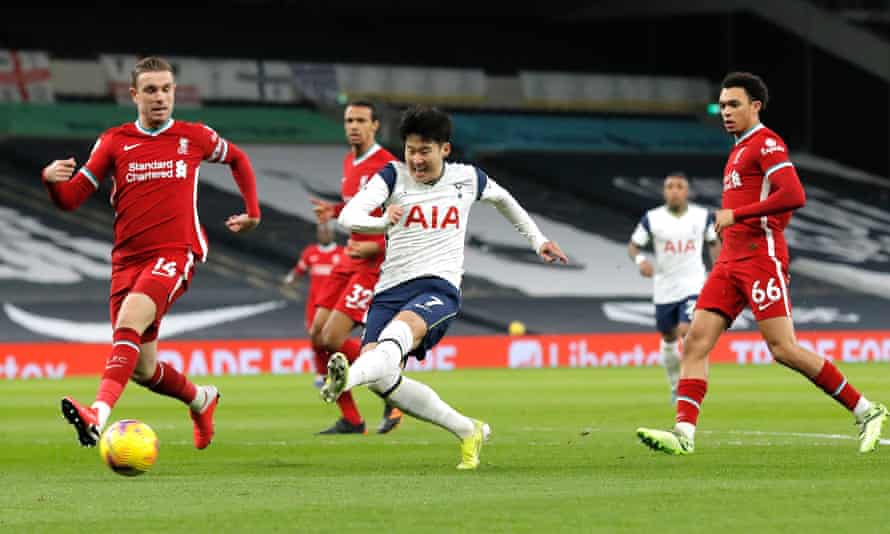Is it done? Have Liverpool, after 40 days without a Premier league win, returned from the wilderness with Thursday’s 3-1 victory over Tottenham? Is that it, doubts over, confidence restored? Certainly the swagger with which Liverpool saw out the game made it hard to understand just how they have failed to score in four league games, how they have somehow let 12 points slip in five games against West Brom, Newcastle, Southampton, Manchester United and Burnley.
Was it just a blip? Just one of those things? Given Liverpool won the shot count in all five of those matches, was it just a case of the forwards being slightly out of sorts? Or was it something more serious? After all, Liverpool haven’t quite been at their very best for a year. Since the restart in June they’ve taken 54 points from 29 games. Projected over a full season that is 71 points, which recent history suggests would be enough to challenge for fourth place, but certainly not the title.
To which the answer, as it so often is in such cases, is probably a bit of both, short-term issues of form and a little misfortune highlighting longer-term questions which have themselves been exaggerated by the present situation. But the good news for Liverpool from Thursday is that when they’re good, they remain very good. Watching them in the second half was like watching somebody wake after a lengthy sleep, belief flooding back into stiff and aching muscles. Sadio Mané and Trent Alexander-Arnold, in particular, suddenly rediscovered the excellence of old.
One of the striking things about Liverpool this season is how little they have changed, despite everything. This is not a normal season. Pre-season was truncated. The calendar is compressed. Players are more tired and more prone to injury than usual, and there is limited time properly to prepare for each game, which means the sophisticated pressing schemes that had come to dominate elite football are much harder to implement.
Everybody is adapting, most notably and successfully Manchester City. Their resurgence remains to be tested against the highest level of opposition, but it’s possible that the difficulties of this season have been extremely beneficial to them and that, by being forced to take a more conservative approach to their pressing, they have found a balance that permits them to play with something close to the same attacking flair as they have always done at their best under Pep Guardiola, but without the vulnerability to balls played in behind their defensive line that has kept undermining Guardiola sides in Europe.
Liverpool, despite all the defensive injuries, have adapted far less. When Nat Phillips came on for Joël Matip at half-time on Thursday to partner Jordan Henderson, it meant Liverpool had used 12 different defensive pairings in the league this season. If the usual level of understanding isn’t there, it’s hardly surprising.

Yet still they play a notably high line and press notably hard. They have not gone for a more conservative approach. No side in the Premier League have made close to their 804 pressures in the final third. To put that in context, the second-most is Sheffield United’s 734. But Sheffield United have the ball far less than Liverpool, so they need to make more pressures to win the ball back. That figure of 734 represents 24.36% of Sheffield United’s total. Liverpool’s 804 is 33.21% of their total. Manchester City are the only team that come even vaguely close, making 29.97% of their pressures in the final third, although in terms of absolute numbers that is 21% fewer than Liverpool.
There is no right and wrong here. These figures help elucidate how a team are playing, not how well they are playing. But it is at the very least intriguing that while the proportion of City’s pressures made in the final third has fallen by 9.46% from last season as they have adopted a slightly less aggressive press, Liverpool’s has risen slightly, by 4.07%.
This, perhaps, is the downside of having a very defined philosophy. For all the benefits in terms of making sure youth development, recruitment and all aspects of training and conditioning are coherent, and for all that the philosophy has underlain Liverpool’s development over the past five years, it can perhaps make it harder to adapt when circumstances change.
The problems from a playing point of view were evident on Thursday in an opening 10 minutes in which Liverpool, once again, looked desperately vulnerable to the counter. Who knows what might have been had Son Heung-min’s third-minute effort not been ruled out for a tight offside.

But the benefits were equally evident. Liverpool’s attacking fluency is dependent on their press. No side in the Premier League are quite so interconnected. Problems at the back create problems in midfield create problems in the forward line. It’s how Liverpool at their best can swamp teams, who are overwhelmed by 11 players operating in unison. And it’s why a slight glitch in one area can have profound consequences elsewhere. But on Thursday it all worked. For long spells, Tottenham couldn’t get out; they didn’t manage a shot after the 48th minute.
It would be absurd to conclude on the basis of one game that everything suddenly has been resolved for Liverpool, and Tottenham’s weird passivity is a significant caveat. But everything suddenly looks a lot brighter at Anfield.
from Football | The Guardian https://ift.tt/2L3uaUK
via IFTTT

No Comment